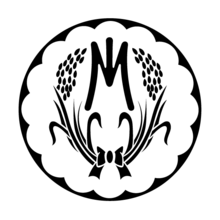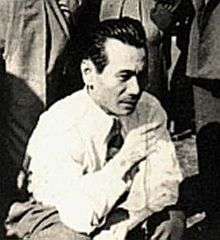Inagawa-kai
 The daimon of Inagawa-kai | |
| Founded | 1949 |
|---|---|
| Founder | Kakuji Inagawa |
| Founding location | Tokyo, Japan |
| Years active | 1949–present |
| Territory | Tokyo |
| Membership | 5,800 |
| Allies | The Sixth Yamaguchi-gumi |
| Rivals | Kobe Yamaguchi-gumi |
The Inagawa-kai (稲川会) is the third largest of Japan's yakuza groups, with approximately 15,000 members. It is based in the Kantō region, and was one of the first yakuza organizations to begin operating overseas.
History

The Inagawa-kai was founded in Atami, Shizuoka in 1949 as the Inagawa-gumi (稲川組) by Kakuji Inagawa.[1] Most of its members were drawn from the bakuto (traditional gamblers), and illegal gambling has long been the clan's main source of income. It has also expanded into such fields as drug trafficking, blackmail, extortion, and prostitution.
The Inagawa-gumi was renamed the Inagawa-kai in 1972.[1] After Kakuji Inagawa, the gang was led by Susumu Ishii, who led it to unprecedented financial prosperity during the 1980s Japanese bubble economy. At one point the clan's assets were estimated to be over $1.5 billion. After Ishii's death in 1990, Inagawa's son Toi Inagawa took over as kumicho and led the clan until his death in May 2005. Yoshio Tsunoda took up the mantle in 2006, heading the clan until his death in February 2010.[2] Kazuo Uchibori may be next in line to lead the clan, but his status as a kyodaibun (blood brother) to Takeuchi Teruaki, a senior member of the Yamaguchi-gumi, may complicate things.
February 2009 saw the Inagawa-kai 'Honbu' (Head Office) relocate from the Roppongi district of Tokyo to Akasaka. There is currently strong resistance from the local political groups and residents of Akasaka meaning that the location of the new Honbu may change yet again.
The Inagawa-kai quietly helped to provide relief in the wake of the 2011 Tōhoku earthquake and tsunami by sending supplies to affected areas. As a whole, the group shipped over 100 tons of supplies, including instant ramen, bean sprouts, paper diapers, batteries, flashlights, tea and drinking water, to the Tōhoku region.[3]
Key persons
Inagawa-kai's renowned figures in the 20th century include Tatsuo Deguchi (known as the "Moroccan Tatsu" or "Tatsu of Morocco"), Kingo Yoshimizu, Kijin Inoue, Takamasa Ishii, Haruki Sho, and Kiichiro Hayashi.[4] Haruki Sho (趙春樹), known as "Gotenba boss", was originally a Chinese national who moved to Japan as a forced laborer with his family. He was best known as the Grand Advisor for the third-generation Inagawa-kai and was one of the most respected godfathers in Inagawa history.
Leadership
- 1st kaicho: Seijo Inagawa (real name: Kakuji Inagawa)
- 2nd kaicho: Takamasa Ishii (real name: Susumu Ishii)
- 3rd kaicho: Yūkō Inagawa (real name: Toi Inagawa)
- 4th kaicho: Yoshio Tsunoda
- 5th kaicho: Kiyota Jiro (Korean name: Sin Byon-Gyu, 신병규)
References
- 1 2 "1993 Police White Paper Chapter 1 : The Actual Condition of the Boryokudan", 1993, National Police Agency (in Japanese)
- ↑ "Friendly fire - Inagawa-kai faces Yamaguchi-gumi takeover", Janes.com. Apr 2010. Retrieved 2010-04-21.
- ↑ Adelstein, Jake (2011-03-20). "Yakuza to the Rescue". The Daily Beast. The Newsweek / Daily Beast Company LLC. Retrieved 2011-03-21.
- ↑ "Yukyo Yakuza-den, Inagawa-kai Grand President", 13 April 2009, Eiji Oshita and Tadashi Ichinose, ISBN 978-4-8124-6941-5 (in Japanese)